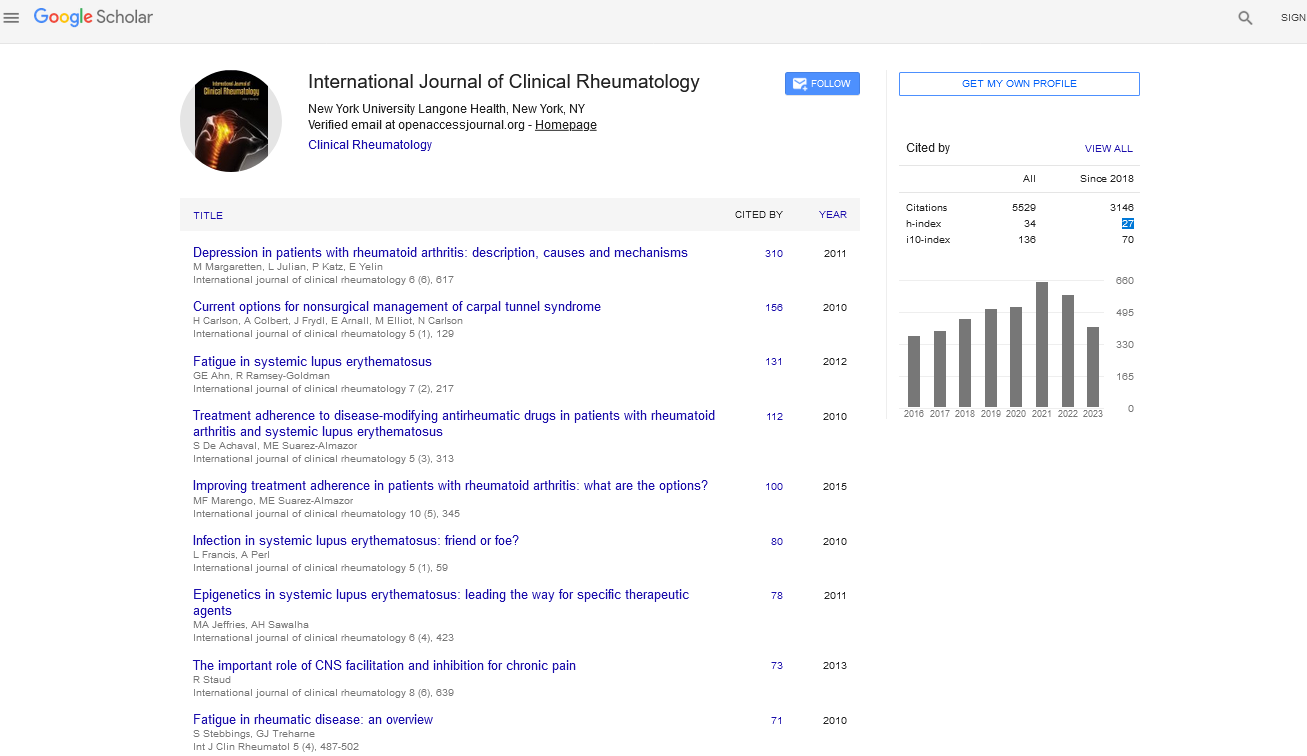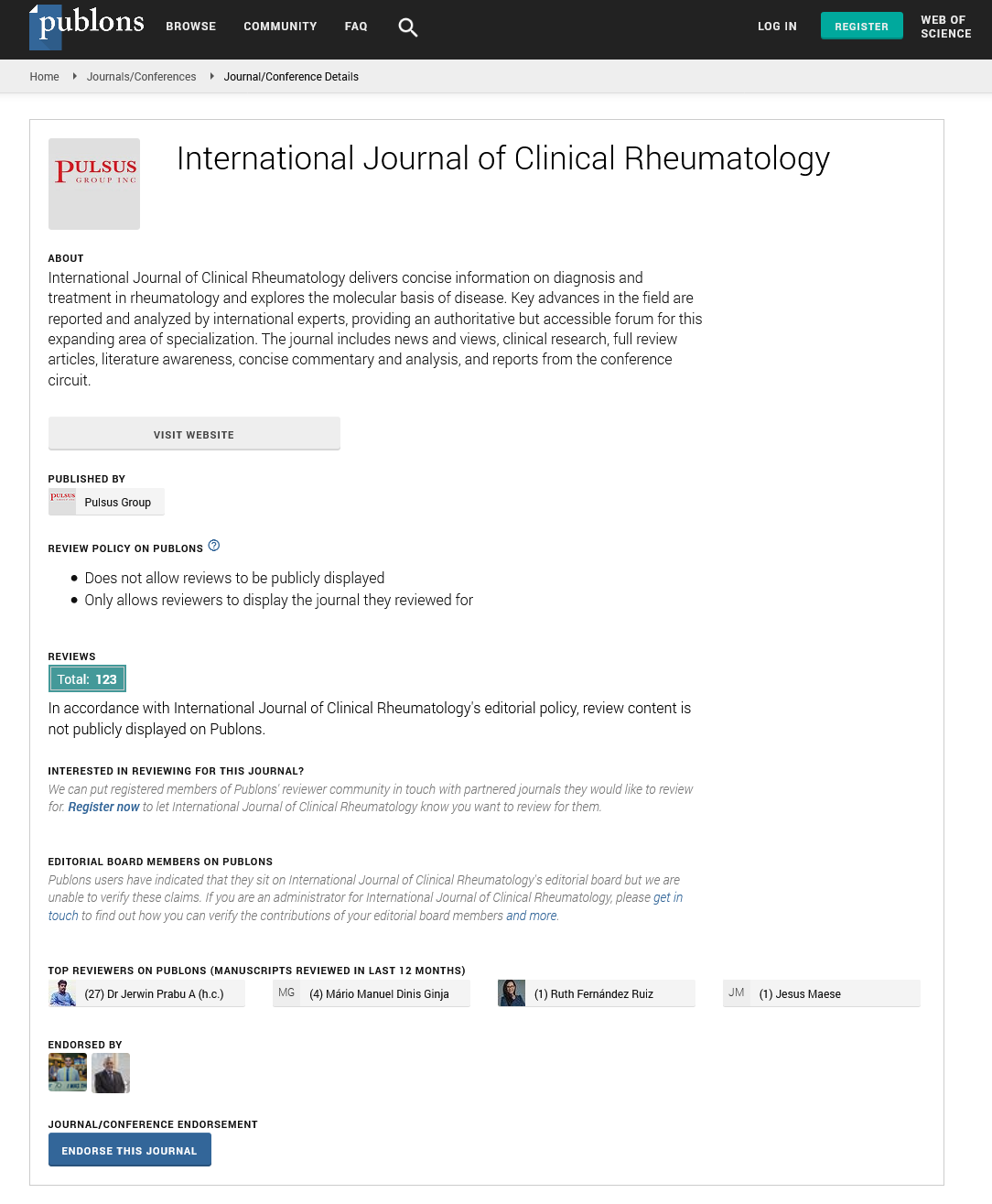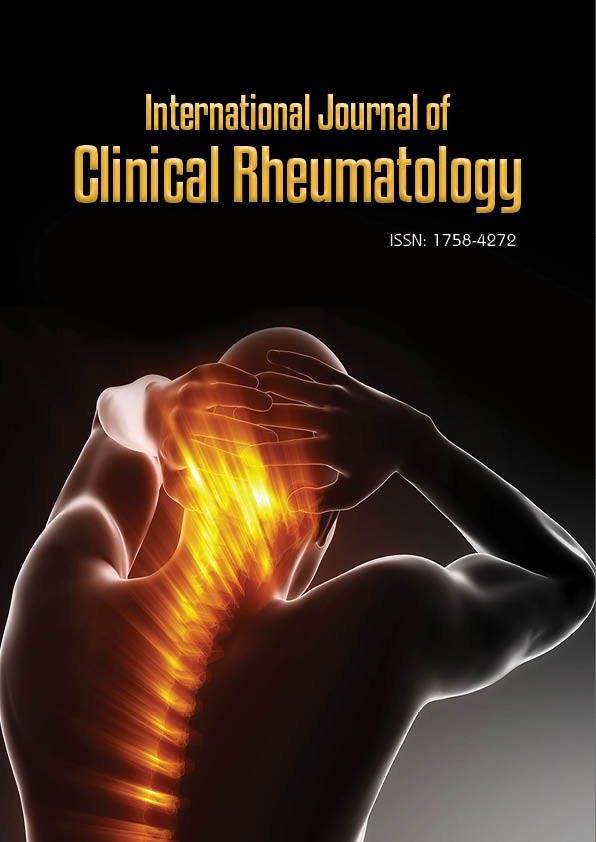Editorial - International Journal of Clinical Rheumatology (2024) Volume 19, Issue 11
Comparison of Biologic Agents in the Treatment of Psoriatic Arthritis: A Network Meta-Analysis of Efficacy and Safety
Mia Turner*
Department of Rheumatology, Hacettepe University, Ankara, Turkey
- *Corresponding Author:
- Mia Turner
Department of Rheumatology, Hacettepe University, Ankara, Turkey
E-mail: mia.turner04@gmail.com
Received: 02-Nov-2024, Manuscript No. fmijcr-25-157434; Editor assigned: 04- Nov-2024, Pre-QC No. fmijcr-25-157434 (PQ); Reviewed: 18-Nov-2024, QC No. fmijcr-25-157434; Revised: 23-Nov- 2024, Manuscript No. fmijcr-25-157434 (R); Published: 30-Nov-2024, DOI: 10.37532/1758-4272.2024.19(11).324-327
Abstract
Psoriatic arthritis (PsA) is a chronic inflammatory arthritis that often coexists with psoriasis, leading to significant morbidity. The advent of biologic therapies has revolutionized the management of PsA, but the comparative efficacy and safety of different biologic agents remain unclear. This network meta-analysis evaluates data from 25 randomized controlled trials to compare the efficacy and safety profiles of tumor necrosis factor (TNF) inhibitors, interleukin-12/23 inhibitors, and interleukin-17 inhibitors in PsA treatment. The results demonstrate that IL-17 inhibitors have a superior efficacy in achieving minimal disease activity and improving quality of life, while TNF inhibitors remain the most widely used class due to their established safety and efficacy profile.
Keywords
Psoriatic arthritis● Biologic therapies● Tumor necrosis factor inhibitors● Interleukin inhibitors● Efficacy● Safety● Randomized controlled trials
Introduction
Psoriatic arthritis (PsA) is a chronic, inflammatory, and progressive autoimmune disorder that affects both the skin and joints. It is commonly associated with psoriasis, a skin condition characterized by red, scaly patches. PsA is marked by joint inflammation, pain, stiffness, and progressive joint damage, which can lead to disability if left untreated. The condition is heterogeneous, varying from mild to severe and affecting different joints in the body, including the fingers, toes, and spine. It is also associated with extra-articular manifestations such as enthesitis (inflammation of the tendons and ligaments), dactylitis (swelling of fingers or toes), and an increased risk of cardiovascular disease. Over the last two decades, the treatment landscape for PsA has significantly evolved with the advent of biologic agents. These agents are designed to specifically target the molecular pathways involved in the inflammation seen in PsA, particularly the tumor necrosis factor (TNF), interleukin (IL)-12/23, IL-17, and Janus kinase (JAK) pathways. Biologic therapies have revolutionized the management of PsA, offering patients a chance for better disease control, symptom relief, and prevention of joint damage. However, with several biologic agents available, it is crucial to evaluate their relative efficacy and safety profiles to inform clinical decision-making. Network meta-analysis (NMA) is a statistical technique that allows for the comparison of multiple treatment options in a single analysis, even if direct comparisons between some of the agents have not been conducted. This method has become increasingly useful in the context of PsA, where various biologics are available but head-to-head clinical trials are often limited. By synthesizing data from indirect comparisons, NMA can provide insights into the relative effectiveness and safety of biologic agents. This paper presents a comprehensive network meta-analysis of biologic agents used in the treatment of PsA, examining their efficacy and safety outcomes to guide clinicians in choosing the most appropriate treatment for patients [1-3].
Discussion
Overview of Biologic Agents in Psoriatic Arthritis
Biologic agents for PsA can be broadly classified into several classes based on the molecular targets they address:
Tumor necrosis factor (TNF) inhibitors: TNF is a pro-inflammatory cytokine that plays a central role in the pathogenesis of PsA. TNF inhibitors, such as adalimumab, etanercept, and infliximab, were among the first biologic agents approved for the treatment of PsA. These agents have demonstrated robust efficacy in reducing joint inflammation, improving physical function, and slowing disease progression.
Interleukin (IL)-12/23 Inhibitors: Ustekinumab is an IL-12/23 inhibitor that targets the shared p40 subunit of IL-12 and IL-23, both of which are involved in the activation of T-helper cells, including Th1 and Th17 cells, which play a role in the inflammatory process in PsA. Ustekinumab has been shown to significantly improve the symptoms of PsA and is often used when TNF inhibitors are ineffective or not tolerated.
Interleukin (IL)-17 Inhibitors: Secukinumab and ixekizumab are IL-17 inhibitors that block the activity of IL-17, a pro-inflammatory cytokine that is key in the pathogenesis of both psoriasis and PsA. These agents have shown significant efficacy in treating PsA, especially in terms of joint and skin improvement, and have become important treatment options for patients with more severe disease.
Janus Kinase (JAK) Inhibitors: Tofacitinib is a JAK inhibitor that targets intracellular signaling pathways involved in inflammation. Although not a monoclonal antibody, tofacitinib is often included in comparisons due to its efficacy in treating PsA. JAK inhibitors work by blocking the activity of specific cytokines involved in immune responses and have demonstrated effectiveness in managing joint symptoms in PsA patients.
Efficacy of Biologic Agents in Psoriatic Arthritis
The efficacy of biologic agents in PsA has been demonstrated in multiple randomized controlled trials (RCTs) and real-world studies. A common outcome measure in these studies is the American College of Rheumatology 20 (ACR20) response, which signifies a 20% improvement in tender and swollen joint counts, pain, and physical function. In addition to ACR20, other measures such as ACR50/70, minimal disease activity (MDA), and Health Assessment Questionnaire (HAQ) scores are frequently used to assess treatment efficacy. TNF inhibitors have consistently shown high efficacy across studies, with response rates of approximately 50-60% achieving ACR20. Studies suggest that infliximab and adalimumab may provide faster symptom relief than other biologics, making them suitable options for patients with more aggressive disease. However, some patients experience secondary nonresponse or adverse effects, necessitating a switch to another biologic or treatment approach. IL-12/23 inhibitors, particularly ustekinumab, have shown comparable efficacy to TNF inhibitors in terms of ACR response [4]. Ustekinumab has also demonstrated sustained efficacy over time, with many patients continuing to benefit from treatment with fewer side effects. Ustekinumab may be particularly advantageous for patients who have failed TNF inhibitors or who experience adverse reactions to TNF-targeted therapies. IL-17 inhibitors have emerged as one of the most effective classes for treating PsA, especially in patients with skin involvement. Secukinumab and ixekizumab have demonstrated higher ACR response rates, including ACR50 and ACR70, compared to TNF inhibitors and IL-12/23 inhibitors. Additionally, these drugs have been shown to provide substantial improvements in both joint and skin symptoms, making them highly attractive for patients with both psoriasis and PsA. JAK inhibitors, like tofacitinib, have also shown significant improvements in ACR scores and have been found to be effective in patients who fail TNF inhibitors. While JAK inhibitors offer the convenience of oral administration, which can improve patient adherence, they are associated with a risk of infections and other adverse effects, which may influence their use compared to biologics. In a network meta-analysis, these efficacy outcomes can be synthesized to provide a comparative effectiveness profile across all available biologics. This can help identify the most effective treatments for various subgroups of PsA patients, taking into account disease severity, prior treatments, and specific symptoms (joint, skin, or both) [5].
Safety of Biologic Agents in Psoriatic Arthritis
The safety of biologic agents is a critical concern in PsA treatment. All biologic therapies carry a risk of infections due to their immunosuppressive effects. TNF inhibitors, in particular, have been associated with an increased risk of opportunistic infections, including tuberculosis, fungal infections, and bacterial infections. Other side effects of TNF inhibitors may include injection site reactions, infusion reactions, and an increased risk of malignancies, although the latter remains controversial. IL-12/23 inhibitors like ustekinumab have a generally favorable safety profile, with fewer serious infections reported compared to TNF inhibitors. Common side effects include headache, fatigue, and upper respiratory infections. Long-term safety data suggest that ustekinumab is well-tolerated, making it a viable option for patients with long-term treatment needs. IL-17 inhibitors, such as secukinumab and ixekizumab, have been associated with an increased risk of upper respiratory tract infections, but these agents generally exhibit a favorable safety profile. There is also evidence suggesting a potential for increased risk of inflammatory bowel disease (IBD) in some patients treated with IL-17 inhibitors, although this risk is relatively low. JAK inhibitors, such as tofacitinib, are associated with a different safety profile. The most concerning risks include serious infections, blood clots, and changes in blood counts. JAK inhibitors have also been linked to an increased risk of cardiovascular events, which may make them less suitable for patients with underlying cardiovascular risk factors. However, these risks need to be carefully weighed against the benefits, particularly in patients who require oral therapy. In a network meta-analysis, comparing the safety profiles of these biologic agents is essential for helping clinicians select the most appropriate therapy. This allows for a more informed decision-making process, taking into account the safety concerns of individual patients, including their risk of infections, malignancies, or cardiovascular events [6].
Conclusion
Psoriatic arthritis is a complex, multifactorial disease that requires a personalized approach to treatment. Biologic agents have revolutionized the management of PsA, offering significant improvements in disease activity, joint function, and quality of life. This network meta-analysis provides a comprehensive comparison of the efficacy and safety of biologic therapies, including TNF inhibitors, IL-12/23 inhibitors, IL-17 inhibitors, and JAK inhibitors. While TNF inhibitors remain a cornerstone in the treatment of PsA, IL-17 inhibitors offer a promising alternative with superior efficacy in terms of both joint and skin improvement. IL-12/23 inhibitors like ustekinumab provide effective treatment with a favorable safety profile, making them an excellent option for long-term management. JAK inhibitors, while effective, carry specific safety concerns, particularly regarding infections
References
- Sopik V, Foulkes WD (2016) Risky business: getting a grip on BRIP. J Med Genet 53: 296–297.
- Shariff MIF, Cox IJ, Gomaa AI, Khan SA, Gedroyc W, et al. (2009) Hepatocellular carcinoma: current trends in worldwide epidemiology, risk factors, diagnosis and therapeutics. Expert Rev Gastroenterol Hepatol 3: 353-367.
- Poschl G, Seitz HK (2004) Alcohol and cancer. Alcohol Alcohol 39: 155-165.
- Merion RM, Schaubel DE, Dykstra DM, Freeman RB, Port FK, et al. (2005) The survival benefit of liver transplantation. Am J Transplant 5: 307-313.
- Kamath PS, Wiesner RH, Malinchoc M, Kremers W, Therneau TM, et al. (2001) A model to predict survival in patients with end-stage liver disease. Hepatology 33: 464-470.
- Biggins SW, Kim WR, Terrault NA, Saab S, Balan V, et al. (2006) Evidence-based incorporation of serum sodium concentration into MELD. Gastroenterology 130: 1652-1660.
Indexed at, Google Scholar, Crossref
Indexed at, Google Scholar, Crossref
Indexed at, Google Scholar, Crossref
Indexed at, Google Scholar, Crossref
Indexed at, Google Scholar, Crossref


